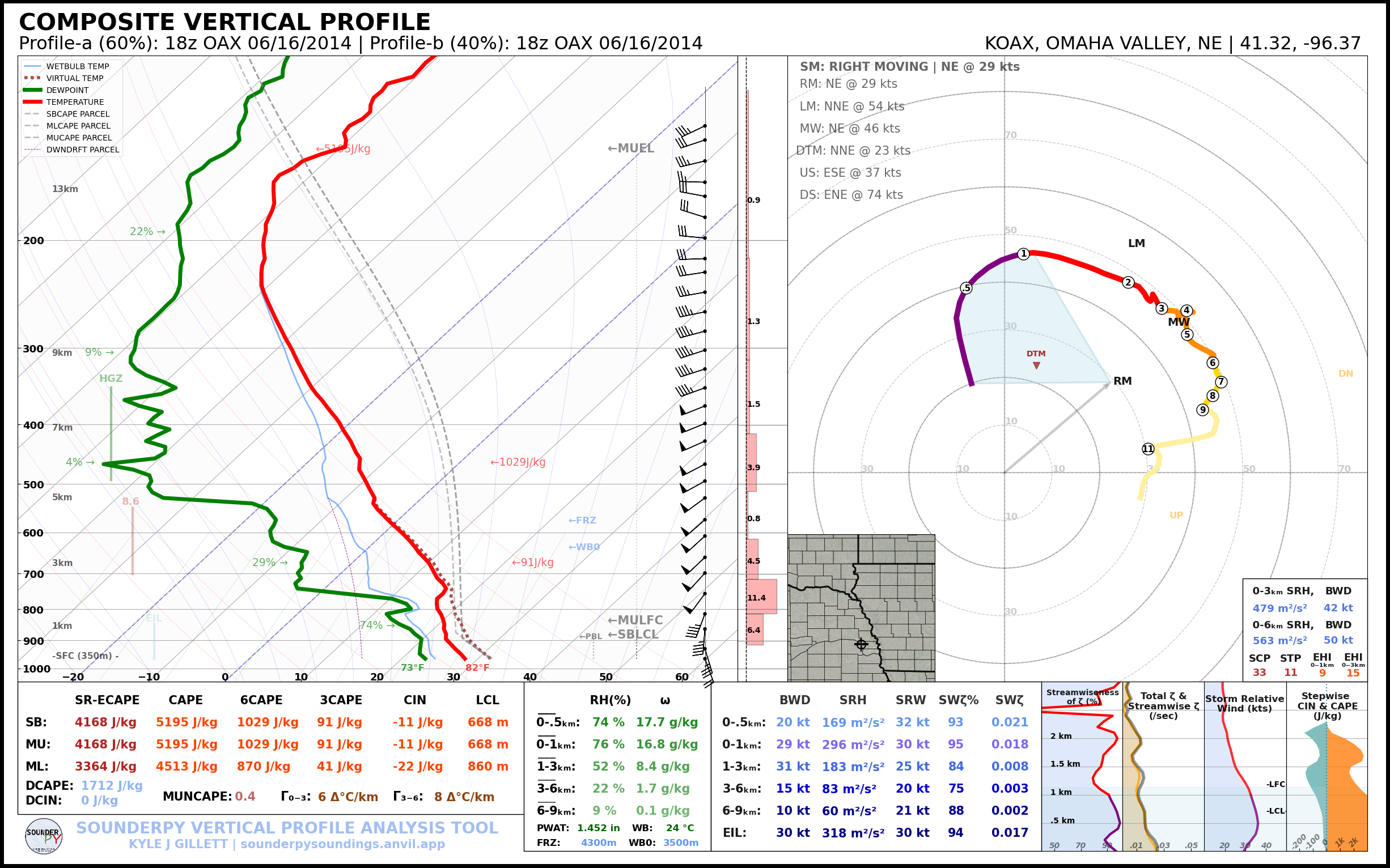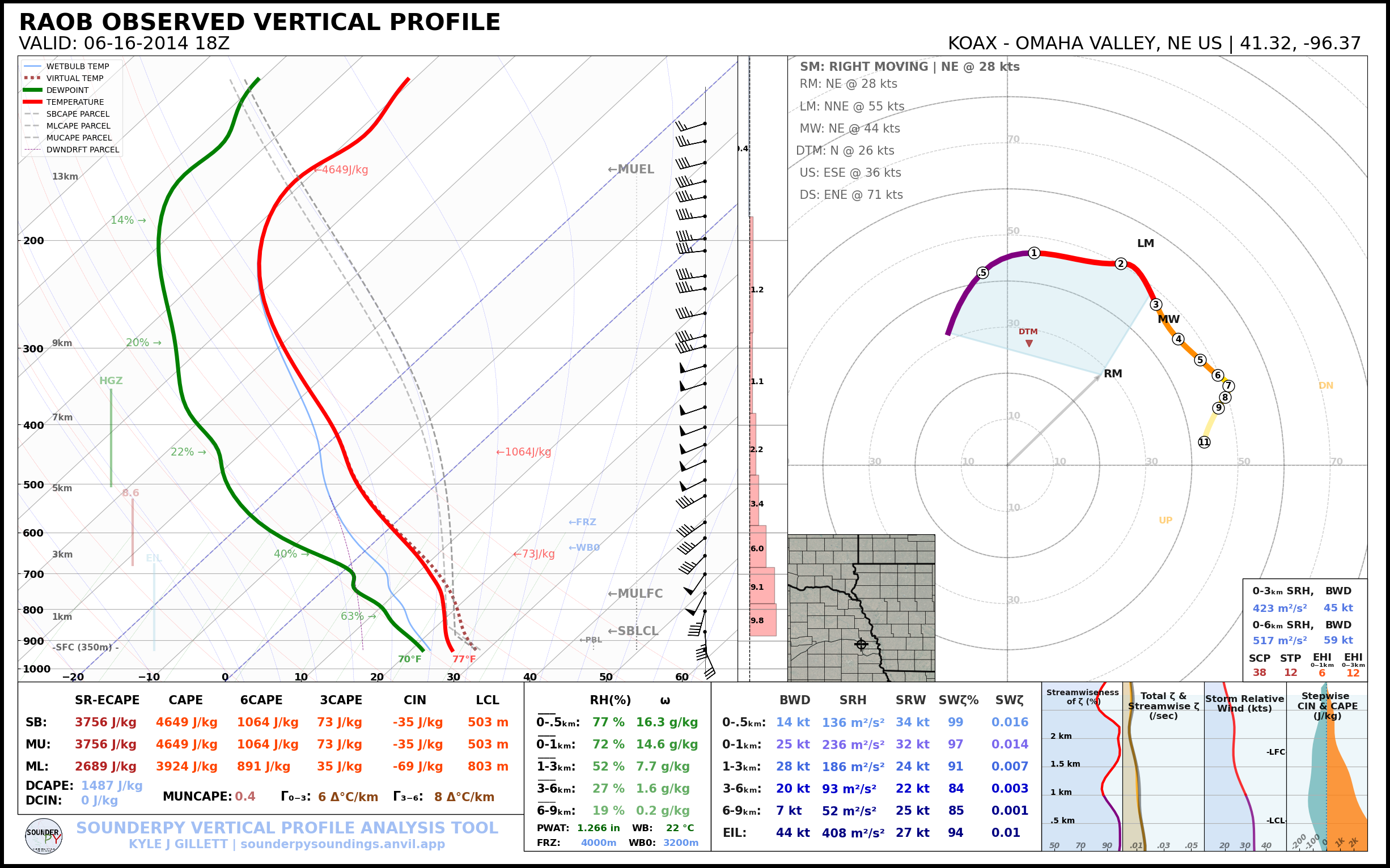🛠️ Helper Tools
A collection of helper tools included within SounderPy.
Returning a dictionary of profile parameters
Return a dictionary of common calculated sounding paramters and special variables for a given vertical profile.
- Data returned in this dictionary include…
an interpolated version of the profile
basic parameters such as mixing ratio, theta-e, wet-bulb, etc
Thermodynamic parameters such as SB, MU, ML parcel properties (LCL, LFC, EL, CAPE, CIN, etc), Entrainment CAPE, etc
Kinematic parameters such as storm motion, storm-relative wind, streamwise vorticity, SRH, composite parameters, etc
- class sounding_params(clean_data, storm_motion='right_moving', modify_sfc=None)
- Parameters:
clean_data (dict, required) – the dictionary of profile data to calculate profile parameters for (see 🌐 Tools for Getting Data)
storm_motion (str or list of floats, optional) – the storm motion used for calculations. Default is ‘right_moving’. Custom storm motions are accepted as a list of floats representing direction and speed. Ex:
[270.0, 25.0]where ‘270.0’ is the direction in degrees and ‘25.0’ is the speed in kts. See the Storm Motion Logic section for more details.modify_sfc (None or dict, optional, default is None) – a dict in the format
{'T': 25, 'Td': 21, 'ws': 20, 'wd': 270}to modify the surface values of theclean_datadict.
- .calc()
- Returns:
special sounding parameters
- Return type:
dict
Example:
spy.sounding_params(clean_data).calc()
Note
These calculated parameters are the same used on SounderPy plots. This function simply returns the master dictionary of all of these values.
Saving data to a file
- spy.to_file(file_type, clean_data, filename=None, convert_to_AGL=True)
Create a file of ‘cleaned’ SounderPy data
- Parameters:
file_type (str, required) – a str representing the file type you’d like to export data to.
clean_data (dict, required) – ‘cleaned’ SounderPy data dict
filename (str, required) – the name you’d like to give the file
convert_to_AGL (bool, optional, default is True) – whether or not to convert height values to “above ground level” when saving to a file. Useful for CM1.
- Returns:
a file of SounderPy data.
- Example:
File options include csv, cm1, & sharppy
spy.to_file('csv', clean_data)
spy.to_file('cm1', clean_data)
spy.to_file('sharppy', clean_data)
Merging two profiles via weighted averaging
Merge two profiles together using weighted averaging of values along a common height axis to return a single profile.
- spy.merge_profiles(profile_a, profile_b, weight_a)
- Parameters:
profile_a (dict, required) – a SounderPy `clean_data`dictionary containing variable arrays for profile_a.
profile_b (dict, required) – a SounderPy clean_data dictionary containing variable arrays for profile_b.
weight_a (float, optional) – the weight for profile_a in the averaging scheme, default is 0.5 (50%)
- Returns:
a clean_data dictionary with weighted-averaged values for z, T, Td, u, v, and p without metadata (see example below)
- Return type:
dict
Example:
# load in some sounding data
profile_a = spy.get_obs_data("OAX", "2014", "06", "16", "18")
profile_b = spy.get_obs_data("OAX", "2014", "06", "17", "00")
# apply `merge_profiles()` function
merged_profile = spy.merge_profiles(profile_a, profile_b, weight_a=0.6)
# reapply profile metadata and plot titles
merged_profile['site_info'] = {'site-id': 'KOAX',
'site-name': 'OMAHA VALLEY',
'site-lctn': 'NE US',
'site-latlon': [41.32, -96.37],
'site-elv': 350,
'source': 'RAOB OBSERVED PROFILE',
'model': 'none',
'fcst-hour': 'none',
'run-time': 'none',
'valid-time': 'none',
'box_area': 'none'}
merged_profile['titles'] = {'top_title': 'COMPOSITE VERTICAL PROFILE',
'left_title': 'Profile-a (60%): 18z OAX 06/16/2014 | Profile-b (40%): 18z OAX 06/16/2014',
'right_title': 'KOAX, OMAHA VALLEY, NE | 41.32, -96.37 '}
# build a sounding
spy.build_sounding(merged_profile, radar=None, special_parcels='simple')

Smooth a profile
Apply a simple SciPy gaussian smoother to a SounderPy clean_data profile
- spy.smooth_profile(clean_data, sigma)
- Parameters:
clean_data (dict, required) – a SounderPy `clean_data`dictionary.
sigma (float, optional) – from SciPy: “Standard deviation for Gaussian kernel”. Default is 0.5.
- Returns:
a clean_data dictionary with smoothed values for z, T, Td, u, v, and p. Metadata remains unchanged.
- Return type:
dict
Here is an (extreme) example:
# load in some sounding data
clean_data = spy.get_obs_data("OAX", "2014", "06", "16", "18")
smoothed_profile = spy.smooth_profile(clean_data, 3)
spy.build_sounding(smoothed_profile, radar=None, special_parcels='simple')

Finding site lat/lon pairs
- spy.get_latlon(station_type, station_id)
Return a latitude-longitude float pair in a
list- Parameters:
station_type (str, required) – the station ‘type’ that corresponds with the given station ID
station_id (str, required) – the station ID for the given station type
- Returns:
lat/lon float pair
- Return type:
list
Example:
spy.get_latlon('metar', 'kmop')
spy.get_latlon('bufkit', 'apx')
spy.get_latlon('raob', 'oun')
spy.get_latlon('buoy', '45210')
note: you can use this lat/lon pair list when calling the function get_model_data
Interpolating a vertical profile
- spy.interp_data(variable, heights, step=100)
Interpolate a 1D array of data (such as a temperature profile) over a given interval (step) based on a corresponding array of height values.
- Parameters:
variable (arr, required) – an array of data to be interpolated. Must be same length as height array.
heights (arr, required) – heights corresponding to the vertical profile used to interpolate. Must be same length as variable array.
step (int, optional) – the resolution of interpolation. Default is 100 (recommended value is 100)
- Returns:
interp_var, an array of interpolated data.
- Return type:
arr
Example:
spy.interp_data(temperature_array, height_array, step=100)
Finding a ‘nearest’ value
- spy.find_nearest(array, value)
Return a value of an index of an array who’s value is closest to a define value.
- Parameters:
array (arr, required) – an array of data to be searched through
heights (int or float, required) – the value used to compare against the array of data
- Returns:
nearest_idx, index of the data array that corresponds with the nearest value to the given value
- Return type:
int
Example:
z_equals_500m = spy.interp_data(z, 500)
Printing data to the console
- spy.print_variables(clean_data, storm_motion='right_moving', modify_sfc=None)
- Parameters:
clean_data (dict, required) – the dictionary of profile data to calculate profile parameters for (see 🌐 Tools for Getting Data)
storm_motion (str or list of floats, optional) – the storm motion used for calculations. Default is ‘right_moving’. Custom storm motions are accepted as a list of floats representing direction and speed. Ex:
[270.0, 25.0]where ‘270.0’ is the direction in degrees and ‘25.0’ is the speed in kts. See the Storm Motion Logic section for more details.modify_sfc (None or dict, optional, default is None) – a dict in the format
{'T': 25, 'Td': 21, 'ws': 20, 'wd': 270}to modify the surface values of theclean_datadict.
- Returns:
prints a number of thermodynamic and kinematic variables to the console.
- Return type:
data print out to the console
> THERMODYNAMICS ---------------------------------------------
--- SBCAPE: 2090.8 | MUCAPE: 2090.8 | MLCAPE: 1878.3 | MUECAPE: 1651.9
--- MU 0-3: 71.1 | MU 0-6: 533.0 | SB 0-3: 71.1 | SB 0-6: 533.0
> KINEMATICS -------------------------------------------------
--- 0-500 SRW: 35.0 knot | 0-500 SWV: 0.019 | 0-500 SHEAR: 21.8 | 0-500 SRH: 186.2
--- 1-3km SRW: 20.9 knot | 1-3km SWV: 0.005 | 1-3km SHEAR: 14.1 | | 1-3km SRH: 54.0